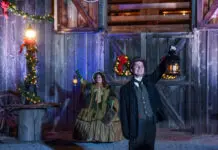Who doesn’t know Carrie Underwood’s story: A farm girl from rural Oklahoma suddenly swept in front of every camera for winning a televised singing competition? Not everyone, however, has read about her Checotah Animal, Town and School Foundation, which purchased music instruments for her old high school, funded her hometown’s spay/neuter program for the animal shelter (which she also built) and shared in installing playground equipment at a town park. Oklahoma still loves Carrie, who has set a new pace and style for country music beyond her American Idol win in 2005. Carrie’s Blown Away Tour hits T-Town Nov. 21 for a 7:30 p.m. show at the BOK Center, 200 S. Denver Ave. Of every ticket sold, $1 will go to the American Red Cross for disaster relief. With prices running $46-$66, that’s sure to be a much appreciated gift. For more, go to www.bokcenter.com. Visit www.okmag.com for a chance to win tickets.
Super Lawyers 2012
The 2012 Oklahoma Super Lawyers list will be available online beginning Nov. 10. You may see the complete list in the November 2012 print edition of Oklahoma Magazine or in the digital edition via the Oklahoma Magazine mobile app.
Steampunked
A woman snug, tight in a steel-boned corset. A man in a double-brimmed hat, puffing a calabash pipe. Brass-rimmed goggles, a necessity on airship voyages. A brass and leather spyglass, for solving mysteries, of course. A vintage mechanical pocket watch and fob.
All were common sights at OctopodiCon 2012, a celebration of all things steampunk, held in Oklahoma City in October.
Steampunk literature and culture venerate the Victorian era, the second half of the 19th century. Steampunk is first and foremost a genre of literature, a mix of science fiction, fantasy and alternate history that draws upon the people and paraphernalia of the steam-powered age.
Never heard of steampunk? Ever heard of The League of Extraordinary Gentlemen? Ever heard of Dr. Who? Ever heard of Girl Genius? Ever heard of Myst? If so, then you have heard of various shades of steampunk.
“Most people have seen steampunk, even if they aren’t aware that that is what it is called,” says Katrina “Kit” Holley, a Norman attorney and OctopodiCon organizer. “Lawyer by day, steampunk prima donna by night,” she jokes.
Noddy Brothers lives in the Oklahoma City suburb of Warr Acres and works as a receptionist at Oklahoma City’s Oklahoma School of Science and Mathematics. Brothers was chair of OctopodiCon 2012.
“First and foremost, (steampunk) is an attitude – exploratory, wondering, creative,” Brother says. “It was a very innovative time period. Telephones, telegraphs, automobiles…you’ve got the whole world opening up. They went everywhere; they did everything.”
It was indeed a remarkable time for literature, the time of H.G. Wells, Jules Verne, Arthur Conan Doyle and Edgar Allan Poe. The time of beloved characters such as Sherlock Holmes and Van Helsing, and much-feared ones like Dracula and Frankenstein. Modern steampunk fiction revisits that fascinating age.
According to OctopodiCon’s website, “Steampunk is a retro-futuristic subgenre of speculative fiction, set in or thematically referring to an alternate Victorian period during which the technologies of the Industrial Revolution achieve fantastic sophistication and power.”
Oklahomans and visitors from around the world celebrated the steampunk subgenre and subculture with classes, authors, art, gaming, a masquerade ball, a charity auction and even a radio-controlled mini-airship race. A few weeks before the convention, Holley says almost 300 people were pre-registered, and two to three times that many were expected to attend.
Both Brothers and Holley were pointed in the direction of steampunk by their youthful love for Doyle’s Sherlock Holmes. Holley also mentioned Verne’s 20,000 Leagues Under The Sea and the science fiction of H.G. Wells. “I have always enjoyed anything with a Victorian flair to it,” she says.
In 2011, both women attended what was probably the first statewide steampunk event, the Oklahoma Steampunk Exposition. A few exposition attendees, including Brothers and Holley, wanted to keep the steampunk fire burning, so they banded together to put on OctopodiCon 2012.
To Holley, the vintage costuming is definitely part of the attraction. She sews and crafts many of her own pieces. “Half the fun is getting to dress up and show off all the stuff you have found and created. It gives me a creative outlet that I don’t get in my job.”
Revealing Motherhood
Motherhood is a job which charges completely inexperienced women to care for, keep alive and mold into bright minds the next generation of the human race. It takes determination, heart and strength. It also takes a sense of humor. Tulsa-born Mary Ann Zoellner wrote the book on it.
Zoellner and her friends hatched the idea for the hilarious, unabashed book, Sh*tty Mom, the Parenting Guide for the Rest of Us over margaritas one evening. Zoellner and co-authors Karen Moline and Alice Ybarbo were swapping nitty-gritty and completely comical tales of stumbling through motherhood. They soon had enough material that a book had to be written.
They wrote a first draft and enlisted comedian Laurie Kilmartin to add her not-so-finest motherhood moments and a little bit of funny to their snark.
The result, Zoellner hopes, will help the rest of us laugh at our less-than-perfect parenting moments. It blows the lid off all the thoughts most moms – and dads, for that matter – have had but were too afraid to say out loud.
Zoellner is an Emmy Award-winning producer who lives in New York City and works on NBC’s Today. She and her husband have two daughters and a very full plate. Zoellner is funny and lively and someone you’d love to have a margarita with. She made time to chat briefly between tucking in her girls and running against deadline for a Today show segment.
Oklahoma Magazine: Do you get home often?
Mary Ann Zoellner: Because of family we always go back. I try to do stories that bring me near them.
OM: You’ve got so much going on. What does a typical day look like for you?
MAZ: Every day is something different most of the time. I’ve been a producer so long. I love that every day is so different. Every day is a big surprise.
OM: How do you balance it all?
MAZ: It’s hard. That’s why I’m a sh*tty mom. Some days my kids get 10 minutes. But it’s the net that matters. You just try to make sure it all balances out.
OM: Where did the idea for this book come from?
MAZ: Three of us came up with the idea over margaritas…maybe too many margaritas. We came up with the idea for Sh*tty Mom sharing our own sh*tty mom stories. Because everyone has a sh*tty mom story. We had too much snark, not enough funny, so we recruited Laurie Kilmartin, who’s a writer for Conan, and she added the funny.
OM: And you have another book, Today Moms?
MAZ: That was a straightforward, baby’s-first-year advice book. All the hosts from Today weighed in. It wasn’t in the same vein as Sh*tty Mom. We wanted to do Sh*tty Mom to make moms laugh. Everything is going to work out and don’t take yourself too seriously. Laugh at yourself.
OM: Have you had any criticism about the book?
MAZ: Only criticism is from people who haven’t read the book. Before you give your opinion, read it first. It’s a shocker to me because the reception is so great. Everyone has a sh*tty mom moment. It’s mostly, “Oh my goodness, I so get it.”
OM: There’s definitely no shying away from anything.
MAZ: It’s kind of like if we’re going to go there, there’s no holding back with anything – language, topics, taboos.
OM: How about your kids?
MAZ: They are 8 and 6 years old. They go to a dual immersion Spanish-English school. We are really, really pleased with the program. They are awesome human beings. I had to warn the teachers this year. “Nice to meet you. I’m Mary Ann and if my daughters say sh*tty …”
Student Innovators
Many college graduates complain that in this economy, even with a college degree, they just can’t find a job in their field. However, some students at Oklahoma’s top universities are working with the private sector even before they graduate, thanks to three innovative programs.
At Oklahoma State University, the New Product Development Center has 22 graduate and undergraduate students working directly with small manufacturers and inventors across the state.
At the University of Tulsa, the McDougall School of Petroleum Engineering has more than 40 students working on projects that involve some of the world’s top oil companies.
At the University of Oklahoma, the Center for the Creation of Economic Wealth has connected 150 students from a broad range of disciplines with inventors and private sector mentors.
The three programs have many significant differences, but they all have this in common: they are providing students hands-on, real-world experience in the private sector. Also, each program claims that by helping Oklahoma businesses develop new products, improve existing ones and take the products to market, they are boosting the state economy and creating new jobs.
At OSU: The NPDC
The New Product Development Center at OSU is in its 10th year. The student interns come from a wide range of academic disciplines, including engineering, business and agricultural communications. The NPDC’s focus is helping Oklahoma’s small manufacturers develop, improve and market their products.
NPDC Director Robert Taylor says, “We have a minimum of 30 projects running at all times. We end up with more work that we can possibly do.”
3C Cattle Feeders in Mill Creek had an idea for a better feeder. Ranchers experience a costly loss when feed falls on truck beds or is stolen by wild hogs and other animals. The central Oklahoma manufacturer turned to the NPDC, which obtained a federal grant to develop 3C’s idea. Since marketing the resulting product, the company reports that sales have increased by $500,000, and three new jobs have been created.
go into more difficult areas, and that results in hiring more people.
In 2008, the NPDC introduced the Inventor’s Assistance Service. The IAS mission is to “help Oklahoma inventors navigate the invention process from idea to the marketplace through education, information and referrals.”
Taylor points to Fence Solutions, Inc., of Enid. The company developed a new fence post clip, the Fence Fork T-Post, which the company says is “faster to put on and harder to knock off.” With help from the IAS, “his business is just growing like gangbusters now,” Taylor says.
At TU: Engineering Consortia
The McDougall School of Petroleum Engineering at TU is the home of nine petroleum-related consortia that give 40 to 50 students the opportunity to work directly with about 60 energy companies, including Exxon Mobil, BP, Shell and Conoco Phillips.
The TU program is quite a bit different from the OSU program. It is older, having been started in 1966, and it is limited strictly to petroleum engineering students. However, the common denominator is that both programs give students the chance to gain real-world experience in their chosen fields.
Department chair Mohan Kelkar explained that in each consortium, a group of companies cooperate to fund research on an industry problem they all would like to solve. Kelkar cites the challenge of transporting “heavy oil,” which is being studied by the High-Viscosity Oil Projects Consortium. Five oil companies each pay $100,000 annually to fund the research, which is carried out by several researchers and technicians and four student research assistants.
“If we can help the industry work in a cost effective manner, they can go into more difficult areas, and that results in hiring more people,” Kelkar says.
At OU: The CCEW
The newest program of the three is OU’s Center for the Creation of Economic Wealth. Founded in 2006, the center’s goal, according to its website, is to “create economic wealth for the university, state and nation by combining the talents of interns, inventors and private sector mentors.”
In the center’s first five years, 150 graduate and undergraduate interns have participated on 26 projects, which the center calls “commercial opportunities.”
Like OSU’s program, the CCEW draws students from many disciplines, including several sciences, business, fine arts, journalism and law. “Commercialization teams” composed of faculty, alumni mentors and student interns tackle real-world problems by providing technical research, market research, benchmarking, financial analysis, fundraising, strategic planning and business plan creation.
The center is overseen by Daniel Pullin, OU’s vice president for strategic planning and economic development. Pullin says CCEW teams “take Oklahoma innovation from the lab to the marketplace, often in the form of spin-out companies which generate knowledge-based jobs for the state.”
The teams have worked on everything from fiber optics to micro financing to water purification to a “baby board” for disabled infants. The center has facilitated the creation of three companies. The center’s Software Business Accelerator aids the creation and launch of software-based products and businesses.
Natural-Born Killer
This past July and August saw wildfires rampage across Oklahoma, destroying homes and more than 100,000 acres of land across dozens of counties, including nearly 60,000 acres in Creek County alone. For State Rep. Richard Morrissette (D-Oklahoma City), there is one villain that stands out among the myriad factors involved in the wildfires that are becoming more and more common here: the Eastern Red-cedar tree.
The U.S. Department of Agriculture describes the Eastern Red-cedar as an invasive, weedy tree. Once found primarily in the hills of eastern Oklahoma, the tree has spread west, overtaking pasture and grazing lands. According to Morrissette, it also plays a dangerous role in wildfires.
“The Eastern Red-cedar played a major role,” Morrissette emphatically attests. “When they burn, they blow up like a bomb. The sap acts like a propellant.”
Morrissette, who has introduced legislation to control the spread of the tree, warns that too little is being done by state agencies to address the issue.
“At OSU in Stillwater they’ve done some mapping and various things to get a number of Red-cedars,” Morrissette says. “But we shouldn’t have to count every tree before we do something. We’ve been too reactionary so far. We wait until the fires have started to even talk about the problem.”
Still, there are those who believe the cedar’s role in wildfires is overstated. Oklahoma State Forester George Geissler says that while the tree plays a role, it’s far from the chief factor.
“The idea that the Eastern Red-cedar is the largest, most dangerous factor in wildfires is absolutely false,” Geissler says. “It is way down on the list of contributing factors in the wildfires we’ve seen this summer.”
According to Geissler, a bigger problem has been poor land management.
“A few years ago when we had the major ice storms across the state,” Geissler says, “there were so many trees that lost limbs, and in many cases those limbs have remained where they fell. Combine that with undergrowth, and all of that is fuel for fires. Add to that the drought we’ve had. Where a tree will normally have 10 to 15 percent moisture, now it will have five to eight percent. What you have is a load of seasoned wood.”
Geissler claims the fires that burned through Mannford, Noble and Luther were hardly affected by cedars.
“(Those) fires were fueled by cross timbers, which are made up of blackjacks and post oaks,” he explains. “If you have a Red-cedar in the middle of a fire, it will burn. But if you limb up the trees around your home and driveway, you’ll be lessening the risk on your home. I’ve seen areas where fires have burned that Red-cedars have been limbed up and are still standing.”
Geissler agrees there is a need for controlling the Eastern Red-cedar, but he believes that focusing solely on the tree in regards to wildfire prevention does Oklahomans a disservice.
“If you only blame the Red-cedar, you make people feel overwhelmed by what they can do,” Geissler says. “A homeowner can do a number of things to make his home safer. You start by limbing up your trees and keeping your lawns cut and cleaned.”
But Morrissette isn’t convinced and continues his crusade to stem the advance of the Eastern Red-cedar. His bill was defeated in the senate, but he is working on new language in hopes of having it passed soon.
“I’m convinced the governor is on board, but there’s still a lot of work to do,” Morrissette says. “Sometimes politics gets in the way of solutions.”
Chef for the Cure
This time of year, we focus on giving – giving gifts and giving of ourselves to those in need. Chef Kenny Wagoner, executive chef of Cancer Treatment Centers of America at Southwestern Regional Medical Center in Tulsa, is in the business of giving his talents, nutritious food and a hopeful spirit to cancer patients who need it most.
For this Irish-born chef, the quest is a highly personal one, as his own mother was diagnosed with cancer in 1997.
After living in several cities across the U.S. and completing an apprenticeship at the Westin Hilton Head in South Carolina, Wagoner settled in Tulsa and took the culinary reins of Tulsa’s Cancer Treatment Centers of America in 2003.
Besides all of the lives that Wagoner touches on a daily basis through his work, he is also credited with starting Chefs for the Cure, an annual event that raises money for the Susan G. Komen Foundation for cancer research and education.
On a day-to-day basis, Wagoner strives to offer patients the freshest, highest quality food possible. Of course, nutrition is important, but even more important is the idea that the patients should eat anything that sounds appealing. The body has to have food in order to heal, but no one is going to eat something that simply does not sound good. Although patients are given options based on dietary needs and wants, they are not bound to those choices.
Wagoner says he has a huge pantry and access to any food patients might want. Whether the request is as sophisticated as lobster tail or as simple as a hamburger, Wagoner is dedicated to doing whatever it takes to help the patients. He adds that familiar, home-style foods like meatloaf, stews and casseroles are most popular because they remind the patients of a time before cancer.
“By offering the patients choices, we give them back some of the control that the cancer took from them. They may not be able to control aspects of their care, like chemo or side effects, but they can control what they eat. The food represents so much more than just sustenance for the body,” he says.
Butternut Squash Ravioli with Sage Cream Sauce
Makes 4 servings
1 lb. butternut squash
1/2 c. diced onions, sautéed
1/4 c. diced prosciutto ham
1/4 c. diced red pepper
1/4 c. chopped walnuts
2 oz. Boursin cheese
3 tbsp. maple syrup
1 tsp. cinnamon
Pinch of salt and pepper
1 lb. pasta dough or wonton wraps
1 egg beaten
Sage Cream Sauce
1/4 c. butter
1/4 c. flour
1 1/2 c. chicken broth, warmed
1 1/2 c. half and half, warmed
Salt and pepper to taste
Freshly ground nutmeg
2 fresh sage leaves
For the ravioli:
Mix first nine ingredients well and set aside. Cut dough into desired shapes. Brush with a little egg. Place a small amount of filling in center of dough. Top with another piece of pasta and crimp edges to seal. Repeat process until all filling is used.
Bring a quart of salted water to a boil. Place ravioli in simmering water and cook for about three minutes. Remove and serve with sage cream sauce.
For the sauce:
In a large saucepan, melt butter over medium heat. Add flour and cook, stirring constantly for a couple of minutes. Whisk in the warmed chicken broth, half and half, seasonings and sage leaves. Cook and stir over medium heat until bubbly; continue cooking for another minute or two. Remove sage leaves and toss sauce with ravioli.
Beyond Blood Bonds
We’ve all seen it, either in person or on the television: a glistening turkey fresh from the oven, family members laughing and passing a basket of rolls while the children load up on pie. Everyone snoozes, follows the Cowboys game, and watches A Charlie Brown Thanksgiving or, for true holiday enthusiasts, White Christmas. Games are played, leftovers are packed up, and the house resonates with humor and warmth. It’s the ubiquitous Thanksgiving scene, a cornucopia of images that Americans have come to expect around the holidays.
That is, some Americans. As youngsters, we learned from our national mythology that during the first Thanksgiving, the Pilgrims sat down with the Wampanoag Indians for a banquet of turkey, cranberries and pumpkin pie before living happily ever after in peace. We know now that the real story went just a little bit differently. These people’s Thanksgiving stories are a little bit different, too.
Firing Up The Feast
For most people, Thanksgiving is a day when the outside world vanishes and time is measured by football and food comas. But for emergency personnel, this day is business as usual, and sitting down at home for a quintessential Thanksgiving dinner is not an option. However, this doesn’t mean they don’t find ways to celebrate.
.jpg) Major Keith McMurphy, a 23-year veteran of the Oklahoma City Fire Department, has seen a lot of on-duty Thanksgivings. He says the fact that everything must be shut down and left every time there is an emergency call makes cooking at the station difficult, but firefighters find ways to work around such obstacles.
Major Keith McMurphy, a 23-year veteran of the Oklahoma City Fire Department, has seen a lot of on-duty Thanksgivings. He says the fact that everything must be shut down and left every time there is an emergency call makes cooking at the station difficult, but firefighters find ways to work around such obstacles.
“Often, the personnel who are scheduled to be on-duty Thanksgiving Day will plan a large meal, invite their families and others whom they know may not have family, and begin preparing the meal for their honored guests a few days before the event,” he says. “Sometimes, personnel will decide to ask family to bring prepared food to the fire station (pot-luck style) in order to avoid the possibility of being too busy with calls to prepare the meal at the fire station and ensure that it will be served when scheduled…In the course of most meals, there will be emergency calls. That is normal.”
Inviting the families to the fire station serves a dual purpose, McMurphy says. While it brings a taste of home and the holidays to fire personnel, it also gives comfort to those who often worry about their loved ones on duty.
“I believe that many family members – spouses, parents, children, etc. – find that the holiday fellowship at the fire station calms many of the normal anxieties and fears they experience when their firefighter is at work,” he says. “Mostly, it is because they can quickly see the bond that we have as a fire company. We live together, we play rough, and we love one another. Those characteristics of a fire station environment are what show a family member that their loved one will not be in harm’s way without several people who absolutely will not turn their backs on them.
“For other people who may not have family or cannot be with their family on Thanksgiving, whether on-duty or off-duty, it is a blessing to be at work,” McMurphy continues. “We work with our secondary family: firemen. It can be a great place to be if you need fellowship and family on a holiday.”
Despite the potential for emergency interruptions, firefighters on duty during Thanksgiving still enjoy many of the traditions most Americans have come to expect this time of year.
“On holidays, we try to relax at the fire station,” says Captain Derak Stewart. “We take care of our daily business, and then we will try to catch some football games and eat as if we were at home with family. The typical traditions would mostly revolve around eating. A lot of eating!”
“We enjoy a holiday meal, a football game, a fire station full of family, and a lighter-than-normal call volume,” McMurphy says. “Those are the goals and dreams of most firefighters as they arrive for duty on a holiday. Those things make a holiday shift special.”
Bounty for the Boys
In 1918, two young boys were found sleeping in Tulsa trashcans. Ever since those first residents were rescued, Tulsa Boys’ Home has been helping troubled male children find their ways to better futures. Residents of the home typically include wards of the state and boys placed there for drug treatment by parents and guardians.
“They are all a little different,” says Executive Director Gregory Conway. “Throughout their stay, we do our best to give them another chance at a happy and successful life.”
Since officially being incorporated in 1919, the home has built almost a century’s worth of special Thanksgiving celebrations for its boys, many of whom never experience the picturesque family dinners of holiday legend.
“For many of our residents, a ‘normal’ holiday has never had special meaning to them,” Conway says. “We try hard to create that sense of family togetherness and instill the role of traditions and holidays. But most of our boys do not have families; therefore, our unique Tulsa Boys’ Home traditions are especially important and meaningful.”
While the staff at the home works diligently to deliver all the typical foods and trappings of Thanksgiving to residents – “The dining hall is filled to the brim with food and people as we all gather together to give thanks and count our blessings,” Conway says – the home has worked to add unique customs to the celebrations. For example, he says, “We have also established new traditions where we take the boys into Tulsa for a delicious meal at a nice restaurant the day after Thanksgiving. Afterward, we all enjoy a heartwarming holiday movie at a local Tulsa theater.”
“The best part of the TBH Thanksgiving holiday is just being together and celebrating this special time of thanks with our boys and wonderful staff,” Conway says.
A Family of Choice
 For many people, the idea of a welcoming Thanksgiving gathering with family is taken for granted. But those who sometimes face rejection at home, such as members of the lesbian, gay, bisexual and transgender community, often celebrate the holidays with another sort of family – one that may not share blood ties, but is loving all the same. This includes many of the guests at the Thanksgiving festivities thrown by Oklahomans for Equality.
For many people, the idea of a welcoming Thanksgiving gathering with family is taken for granted. But those who sometimes face rejection at home, such as members of the lesbian, gay, bisexual and transgender community, often celebrate the holidays with another sort of family – one that may not share blood ties, but is loving all the same. This includes many of the guests at the Thanksgiving festivities thrown by Oklahomans for Equality.
“Our event is for people to be around their ‘family of choice,’” says Toby Jenkins, executive director of Oklahomans for Equality and the Dennis R. Neill Equality Center. “Many LGBT people are alienated from their families, or their same-sex partners are not welcome. Many transgender individuals are not welcome in their families’ homes. We provide a traditional family Thanksgiving experience for all of those who are not welcome at home or not accepted by their birth families.”
Oklahomans for Equality tries to make each year’s event inspirational and comforting for attendees, offering them a home away from home for the celebration. The day is packed with special traditions, entertainment and bonding between attendees. “Every year, we feature outstanding dinner entertainment in our ‘Come Home for the Holiday,’” Jenkins says. “Last year we had harpist Linda Paul, who took requests from the audience. We post pictures on our Facebook page of special Thanksgiving greetings that attendees send out to the community. We have a moment of silence to allow people to contemplate things they are grateful for. We read off the beneficial advances for equal rights for marginalized communities locally and nationally as a part of the things to be grateful for. We play games with the winners getting the centerpieces. And we allow people to share stories of inspiration.”
Assisting Oklahomans for Equality with the feast is an affiliation of faith organizations that welcome the gay community, as well as straight parents and families who wish to provide support at the dinner. “Each year, we see more and more families with children participate so those children see their same-sex parents connect them to lots of Tulsans just like their family,” Jenkins says.
The holidays are a difficult time for some members of the LGBT community, but Oklahomans for Equality, their partnering faith communities and local families strive to mitigate this with a particularly positive celebration. “Each year, we have young people who just ‘came out’ to their family, and it did not go so well because the parents are dealing with religious stigma of having a gay child,” Jenkins says. “It is such a tender moment to hear these LGBT young people express appreciation to know we will be their family as their parents come to accept them. They get to meet other parents who can reassure them that things do change and parents can eventually come to accept them.”
Making Merry With Many
Once upon a time, Clay and Holly Morris were despaired trying to have more children. They had no idea that one day, they would be celebrating Thanksgiving with eight.
“We had a plan for starting our family, but our plans didn’t work out,” Holly Morris admits. “We always say that we are so thankful they didn’t.”
While waiting to conceive again, the couple decided to channel their love to children in need of foster homes. Over the next few years, they fostered several children while adding to their own biological family. When one of their previous foster children passed away, leaving infant twin daughters, the Morrises formally adopted the girls, thus starting on the path that would bring them not only four biological children, but four adopted children as well. The Morris children range in age from 2 to 20, making Thanksgiving in their household a larger-than-life event.
In addition to celebrating the holiday with their children, the Morrises also include another family each year, who bring their own three biological children and four foster children along for festivities.
“Talk about a houseful! We celebrate a weekend of Thanksgiving, not just a day,” Morris says.
The biggest tradition in the Morris household is honoring the true spirit of Thanksgiving by remembering for what – and whom – they are grateful. “We all, at least most of us, name one thing we are thankful for each year,” Morris says. “Never has there been a year that a person hasn’t been named. People, life, children…those are what we are most thankful for. It is an event, not just a meal, and a celebration of what we are most thankful for. It’s flexible and evolving, while holding to American traditions. We look forward to seeing who will be joining us each year.”
A Home for the Holiday
Perhaps more than any other American holiday, Thanksgiving evokes images of loved ones and a place to call home. But for those who have no homes or families, there is still a special place to celebrate the event. City Rescue Mission, an Oklahoma City faith-based organization, has been providing food and shelter for the city’s homeless population for more than half a century, serving an average of 350,000 meals each year. Approximately 900 homeless and volunteers attend the mission’s annual Thanksgiving feast. While this may sound daunting to some, president and CEO The Rev. Tom Jones says high attendance isn’t the distinguishing factor of the meal.
 “The thing that makes it so special is the fact that so many wonderful volunteers come down to participate in this special day of giving thanks,” he says. “The volunteers make a tremendous impression on the homeless individual because the homeless know that these volunteers could be any place in the world they chose to be that day, yet they chose to spend it with them. This is such a powerful statement of acceptance and encouragement to the homeless. It is an amazing impact on the children of the volunteers when they truly see that many are not as blessed as they are with a family that loves them and supports them. I truly love to see the interaction between the homeless person that feels so lonely and forgotten and the volunteer that gives their time and holiday to share with those in need.”
“The thing that makes it so special is the fact that so many wonderful volunteers come down to participate in this special day of giving thanks,” he says. “The volunteers make a tremendous impression on the homeless individual because the homeless know that these volunteers could be any place in the world they chose to be that day, yet they chose to spend it with them. This is such a powerful statement of acceptance and encouragement to the homeless. It is an amazing impact on the children of the volunteers when they truly see that many are not as blessed as they are with a family that loves them and supports them. I truly love to see the interaction between the homeless person that feels so lonely and forgotten and the volunteer that gives their time and holiday to share with those in need.”
The mission’s celebration, which is open to anyone in the community, boasts all the accouterment of the customary holiday, including turkey, dressing, mashed potatoes, pumpkin pie – and family. Volunteer families each sponsor tables, bringing with them their favorite decorations and desserts, before sitting down as a whole to share the comforts of family and warmth with homeless individuals.
Jones says the holiday is a reminder of how giving the citizens of Oklahoma City can be.
“We live in a time when it is easy to forget about the less fortunate,” he says. “A true measure of the health of a community is to see how they treat and care for their underprivileged. We truly are blessed to have a community that takes care of its impoverished.”
*The Dennis R. Neill Equality Center is open every day of the year, and serves Thanksgiving dinner at noon. To RSVP for the event, contact [email protected], and visit www.okeq.org for more details.
*City Rescue Mission is open every day of the year, and serves Thanksgiving dinner at noon. For more information, call 405.232.2709 or visit www.cityrescue.org.
*If you are interested in becoming a foster or adoptive parent, Oklahoma’s children need you. Contact the Bridge Family Resource Center at 800.376.9729 or visit their website at www.okbridgefamilies.com.
Wine Notes: A Vintage Holiday
It can be a challenge to match wines for a meal as extensive and diverse as a traditional Thanksgiving dinner. But it is also a great opportunity to experiment if keeping just a few principles in mind.
One wine from appetizer to dessert is definitely a challenge, with sparkling wine being one option that’s both popular and appropriate. A drier Rosé is also an option and will pair reasonably well with several courses. It’s slightly easier to remain committed to either red or white wine from beginning to end, but to do that or to switch between the two is a matter of personal taste. In white wine, Riseling pairs well with well seasoned turkey, dressing and sweet potatoes. Crisp Sauvignon Blanc nicely cuts the richness of turkey and mashed potatoes. Pinot Grigio also holds up well to fatty dishes.
Among red wines, Pinot Noir is a holiday classic that buoys Thanksgiving’s earthier flavors. Zinfandel is a little heartier accompaniment for those so wishing. A peppery or spicy Syrah can add another, deeper layer to the more savory components of the Thanksgiving meal. Beaujolais Nouveau is famously released from France just prior to Thanksgiving in the United States and for a fruity, light wine, actually pairs well with traditional fare.
Whatever you pair throughout the meal, for dessert consider a fortified wine like port or cream sherry – either will put the exclamation point to your pumpkin or pecan pie.






















